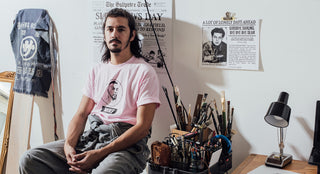Adam Villacin’s first words to me were ten years ago, during a lunch break from the high-end retail store we both worked at in West Hollywood. He passed me reading Lolita in the grass on his way back from Swingers on Beverly.
“That’s a good book,” he said.
“ I know.” I replied.
“I bet you’re at the part where he’s like, talking about how beautiful she looks when she cries.”
I looked up. I was precisely at that part.
“That’s cool,” he continued. “Actually, I want to read that part again,” and put out his hand. I gave him the book and he read the passage silently to himself while I stared. Once satisfied, he handed it back.
“Yup, that’s a really good part,” he said, and walked off.
It was the early aughts, and his tight neon wardrobe, electroclash mullet, and slow manner of speech seemingly coalesced into a parody of its particulars that broke the moment he opened his mouth. I have been a fan ever since—first and foremost of his work, though his wardrobe is not far behind. Adam’s fascination with culture, both sub and pop, manifest in a catholic range of lewks. One day he sports a perfectly informed boots-and-braces skinhead combo. The next he might be wearing what I call a Drake Turtleneck (“That’s actually a Yeezy Turtleneck” he corrects) and louche sweatpants.
This slippage between how Adam outwardly presents himself and whatever constitutes his inner life characterizes his entire practice.
Under the deceptively simple title of illustrator, this practice is framed in a number of ways. Adam plays the liminal space between information and its methods of presentation, pulling the curtain back on knowledge-value while skirting the dull task of making a value judgement. Comic book history and zine culture are the main inspirations for his stippled, almost storybook style of illustration (Shel Silverstein and Robert Crumb lurk obliquely behind his pen) that tends to favor the book and tee shirt as potent, unassuming modes of communication.
So... Adam makes ‘zines and tee shirts and stuff. For himself, for clients, for museums, for friends, for you. His inspirations are less indebted to imagery than the formal and distributive properties of a medium. From Dead Wrestlers to superstar athletes, to titans of California Conceptualism, Villacin looks at culture with an eye turned on its ear. We spoke via Gchat and email in the wake of the Recent Unpleasantness.
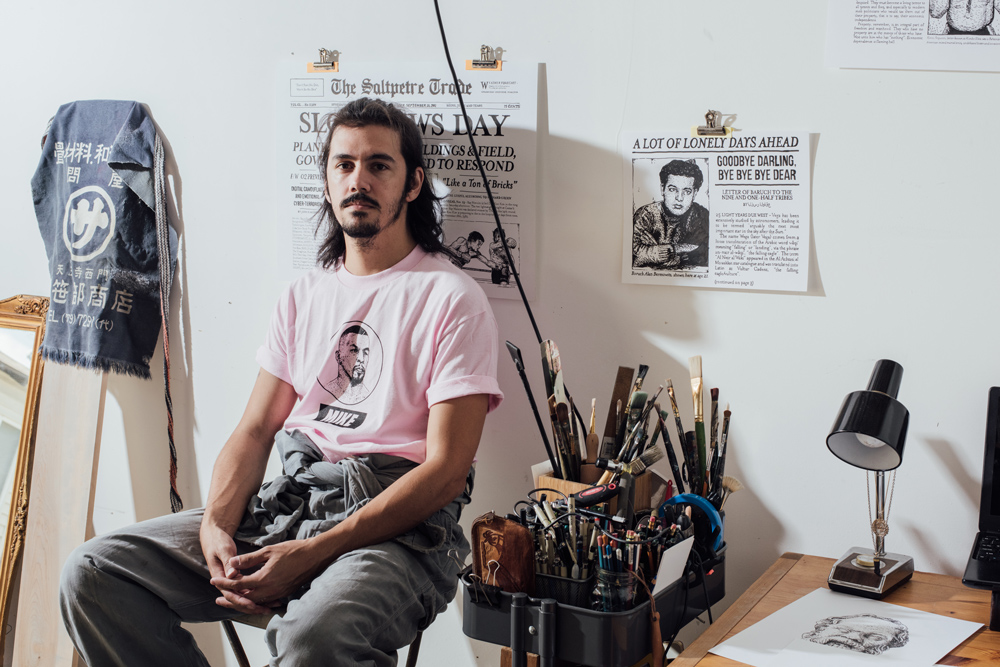
CHRISTINA CATHERINE MARTINEZ: What did you study in art school?
ADAM VILLACIN: I was in the art program at CalArts. I got in on a portfolio comprised of embarrassing paintings and I didn’t paint the entire time I was there, though I did have one significant show; sculptural work that was really, really sincere. It was the focus of my mid residency review, and my mentor and other professors shit all over it.
They asked me to leave the room and I did that thing where you make the sounds of footsteps getting quieter so I could eavesdrop—oh god this is so cartoonish—and the first thing my mentor said was, “Well, he’s full of shit.”
Which I certainly was, often, but not this time. That bummed me out.
Maybe you’ve pre-empted my next question then—what made you turn to the zine / comic book format as opposed to say... painting or found sculpture or experimental dance?
Honestly? I didn’t start making visual art again seriously for years. I lived through my 20s doing whatever, eventually landing a job art assisting for someone. I painted about three huge paintings a day for this person, big abstract expressionism pieces and pictures of hot women in bikinis. Five by six feet. After a couple years of that I was interested in making art for myself again, and I think working small was a product of my environment—which is a desk in a small apartment.
I didn’t set out to make zines per se. I never stopped making these books, but they weren’t exactly artist books... The illustrations I was making were all collections. A body of work with say, twelve pieces. It made sense to collect them into zines, but somewhere along the way I started making these collections with the intent of them being zines from conception.
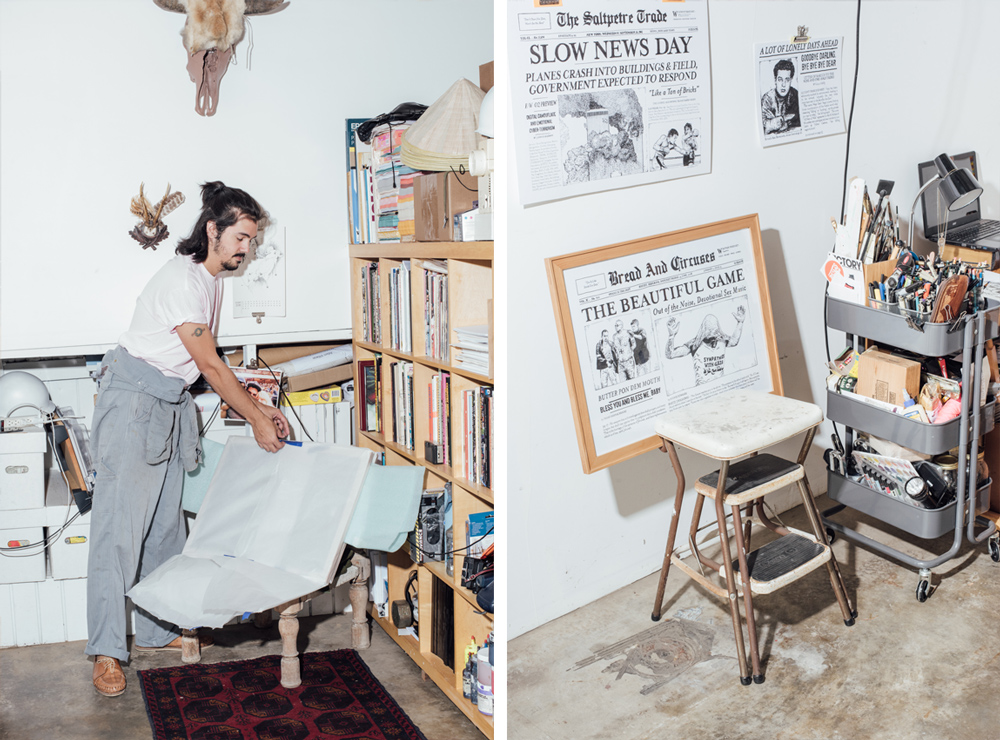
You seem unperturbed by the division of a “commercial” versus a “personal” practice—the merchandise and the original work are given equal care.
I don’t see any nobility in separating an art practice from making a living. Why is it better to be a stoic and suffer through a shitty job rather than applying your skills to feed yourself? I think a lot of artists with similar backgrounds and education to me have this mid-brow dilemma, where we have certain levels of art school education, but chose not to participate in the completion of the cycle. We are blessed with critical thought and cursed with having to exist outside of that world. We have very few role models and have to carve a path for our work. I think making zines, T-shirts and skateboards allow us to speak to audiences that might not necessarily have access to other forums.
That makes sense. your subject matter is diverse to say the least.
It’s a reflection of something. What ties it all together is the idea of categorizing or archiving culture. It’s all loosely about cultures, subcultural signifiers, identifying and examining…
So... the through line from cataloging Aggressive In-Line Skate Grinds and Sudanese warriors is not so tenuous as people might think?
Ha! When you present it like that it is... but it’s not. They are both things that are cool to me.
I have genuine interest in both, I and wanted to take a look at why. When I did the Sudanese warriors, I’m not sure I knew what I was doing yet, wasn’t quite in my groove.
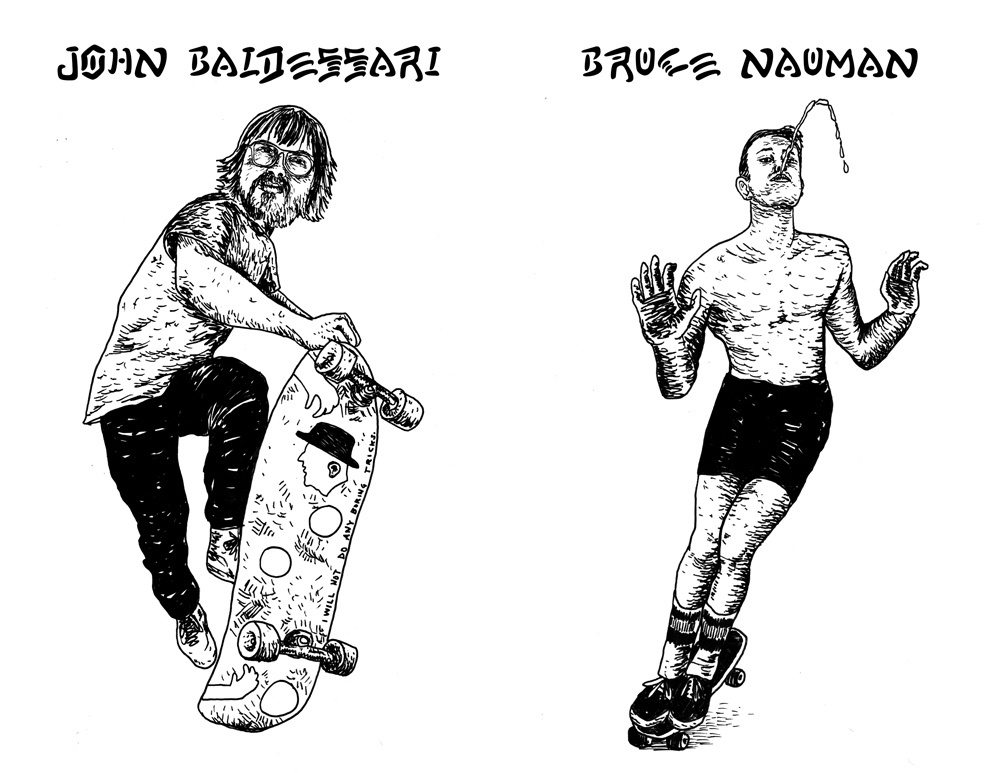
John Baldessari, Bruce Nauman, details from California Concepts, zine, 2014
Well, the word “culture” is very broad. Maybe it’s not productive to find the through line. I mean, damn, how about your subjective interest is the through line? Isn’t that enough?
I hope so.
Do you think irony is a productive disposition?
To be consciously ironic, I think you have to have a level of awareness, an understanding of something to recontextualize it. I’m not sure if I make ironic work. There is a harsh critical aspect to my work, and a lot of humor, but I’m quite sincere about it. To be productive, and initiate any change, I think the high-horsedness that the position of irony puts you in can be offputting to people and work against you.
I think the absence of irony is what sets your work apart from many artists who deal in cultural signifiers.
Oh that’s interesting, I like that... well, let me give you a little backstory: that mid residency show at CalArts? All of the sculptures were about self help—self improvement I should say—in a very sincere way. And these fucking dinosaurs, brought up as they were, and toughened in the very ironic 1990s, couldn’t believe that someone would make serious work about it.
Oh wow. Yes, the cultural mood has changed since then. We quickly realized how exhausting the upkeep of irony is. Now grown adults talk quite sincerely about things like improvement and self-care.
I know! It’s great. I think to be ironic, you have to think of yourself as above something, and I don’t think I’m above the subjects I make work about. I like them all for the most part; but even if I don’t like a subject, I try to approach it from even ground.
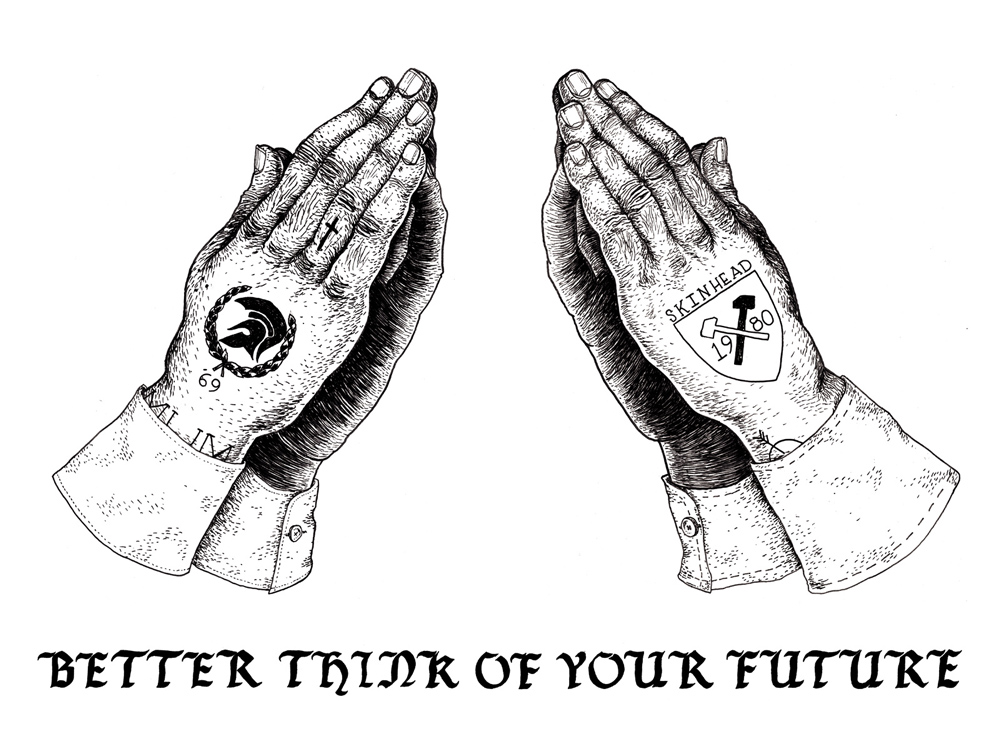
Better Think Of Your Future, from “Pobody’s Nerfect” at KK Los Angeles Gallery, silkscreen on bristol, 18″ x 24″, 2014
You often revisit skinhead culture as a subject. What is it about this subculture in particular that fascinates you?
Skinhead subculture, as a whole, is kind of an umbrella term for a number of vastly different microcultures, with a unifying element—the uniform. What I find compelling is the durability of the skinhead aesthetic, and the mythology of the rudeboy and the hard mod. Skinhead culture has come a long way from dancehall crashing and the Spirit of 69. Through different waves, different generations, different political stances, the idea of the skinhead has morphed into so many different things. Could Symarip have foreseen Ian Stuart? Or the existence of SHARPS in places like Palmdale? Or the subculture of Doc Marten fruit crushing videos on YouTube? I’m excited to see what post-post-(…) skinhead adjacent subculture emerges from the new fringe-right fascist movement here in the US.
Do you think it’s possible to skip punk and go straight to punk damage?
Resoundingly, yes! If you latch onto the right signifiers, you can skip anything. Mathematics of poseur culture 101, what looks cool? It’s never been easier to steal, borrow, appropriate. I think I make work attempting to give context to signifiers because lonely signifiers without context are mostly all we have left. If the internet is what we use to share culture, then aggregators and feeds are our city centers. Scrolling through picture after picture becomes a time based media in the worst way. We catch glimpses of things and assume that we get the gist of it. It’s like reading a headline and not the article. There’s some sort of vaguely Buddhist metaphor to be found here—what is the sound of a rock in a cop’s face if no one’s around to throw it?
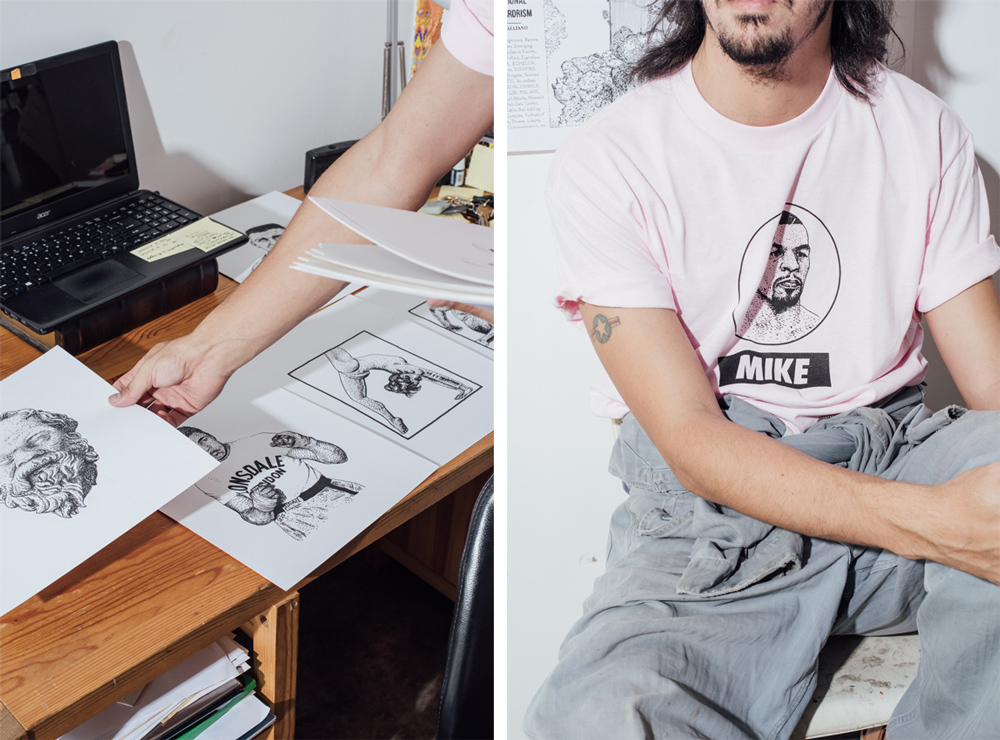
I want to go back to this approach from “even ground.” It’s very present in your books and zines and objects, and the newspaper drawings feel like a definite shift. The approach is unclear, which is unnerving.
Agreed. I’m still figuring it out in a way... I felt the zines all have this very informative quality: here is a thing I discovered, and I want to share it with you. But that method of communication is very direct, and after 50 or so zines I grew weary, or at least said what I had to say.
The newspaper headline illustrations are partially a response to my own method of information intake—400 open tabs with one thing pointing in another direction that I have to see before I even understand the first thing. So, each drawing is loosely about something, and comprised of drawings, text, poems, quotes, proper nouns of a million parallel and peripheral subjects...
I think the unnerving aspect is a recognition that most of us get our information in this schizo-surface-surfing way, which is admittedly not the best way to stay politically informed.
Absolutely. Plus the disinformation that comes from news aggregates, just reading the headlines and sharing with friends or strangers, not even reading the article. It’s information skimming.
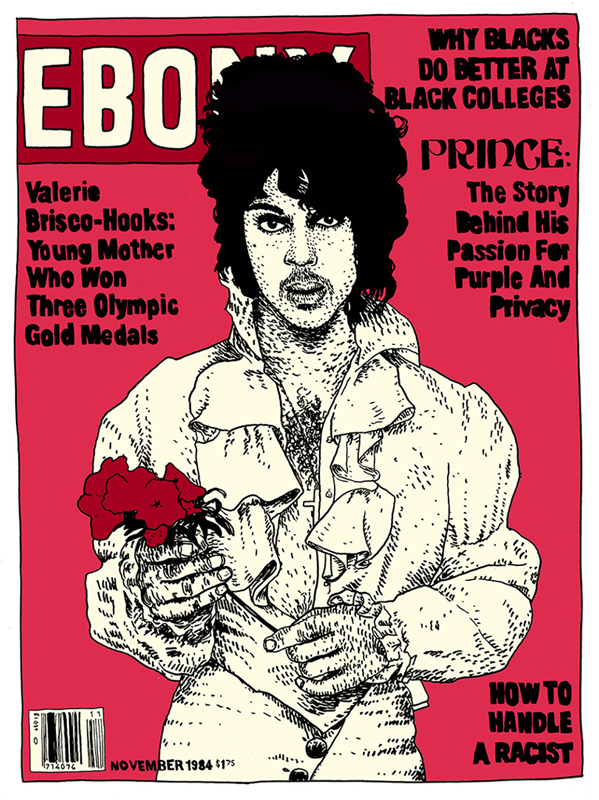
Prince, from “VICE Tribute to Prince” ink on bristol, digitally colored, 11″ x 14″, 2016
There’s a lot of talk about media literacy and the media landscape being inscrutable or equivocal. Looking at the newspaper drawings really enacts that confusion... they’re sort of “about” something, but not really saying anything. and you present it in this format that’s traditionally revered as being informative, objective.
There’s an implicit trust that the viewer takes on, that I must have done research and the things on the page are relevant, that they belong there. But really, how the fuck? I couldn’t expect anyone to understand it all and get every reference. I want people on their phones looking things up when they’re standing in front of a newspaper piece.
For me, that impulse is part of experience. Each newspaper drawing loosely has a theme—or I should say concern. And when you start getting into it, when I start Googling these references and looking up quotes, it’s like the newspaper is now a hypertext. And there’s no answers, just more questions.
Wow. That’s really accurate in a way I’ve never considered.
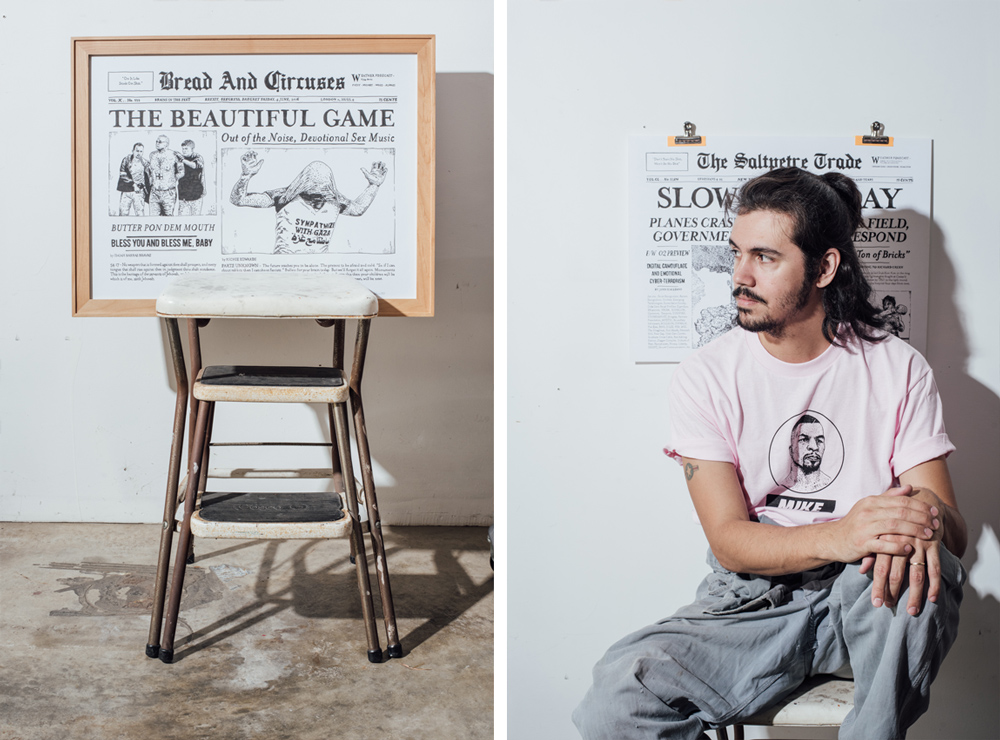
When did you start them? I can’t help but feel like they’re informed by the political climate we’ve had this year.
I’d been playing with the idea, but being asked to contribute to the group show [“What a Time to Be Alive” at Slow Culture] is what made me actually make it. I guess that was the beginning of 2016. What a time, right? I think that title, as an invitation, allowed a lot of people to be political and personal at once.
Bad art is nothing if not sincere, but that’s a risk more of us should probably take.
With the way media is consumed now, even if you fail, people generally forget about it pretty quickly. That’s a legit upside to our shortened attention spans.
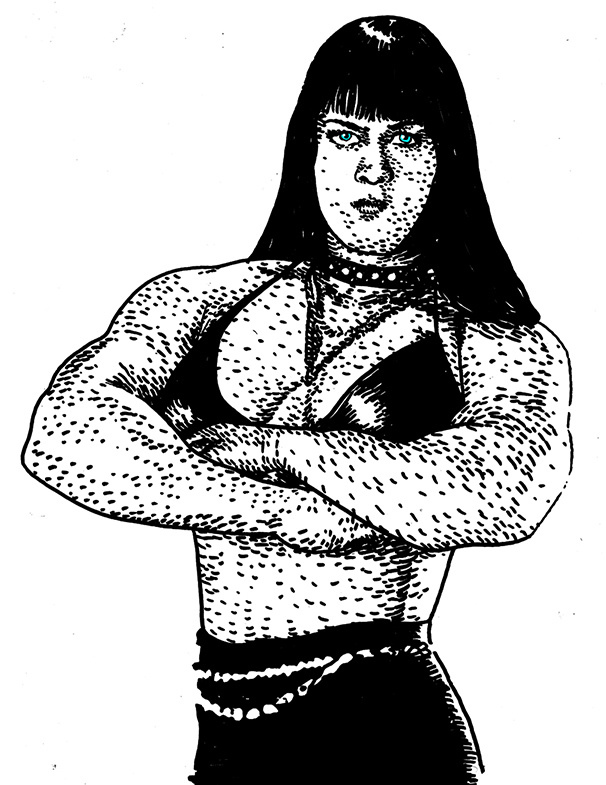
Joanie Laurer, detail from upcoming Dead Wrestlers 3, zine, 2017
Finally, what fall fashion trends are you excited about the most?
I’ve always been one for statement furs and velvet, but since 2016 was an election year, political thought is the lane in which my mind has been anchored. I feel that we’re at the culmination of one age and beginning of another. Where the PATRIOT Act began to roll back civil liberties, I think we are going to see massive advances in spying, censorship, corporate rights over human rights, all on a global scale. There isn’t another logical outcome for a capitalist society. We can also anticipate many more deaths of great men and women. I think we’ll look back at 2016 and say “Hey, remember when we thought losing Bowie and Prince and Leonard Cohen and Muhammad Ali and Fidel Castro was bad? Simpler times.”
That being said, I look forward to the great art and stories of human triumph that are born from difficult times.
***
adamvillacin.com. Buy books and shirts by Adam at bosstresbien.com.
Photos by Graham Walzer.

